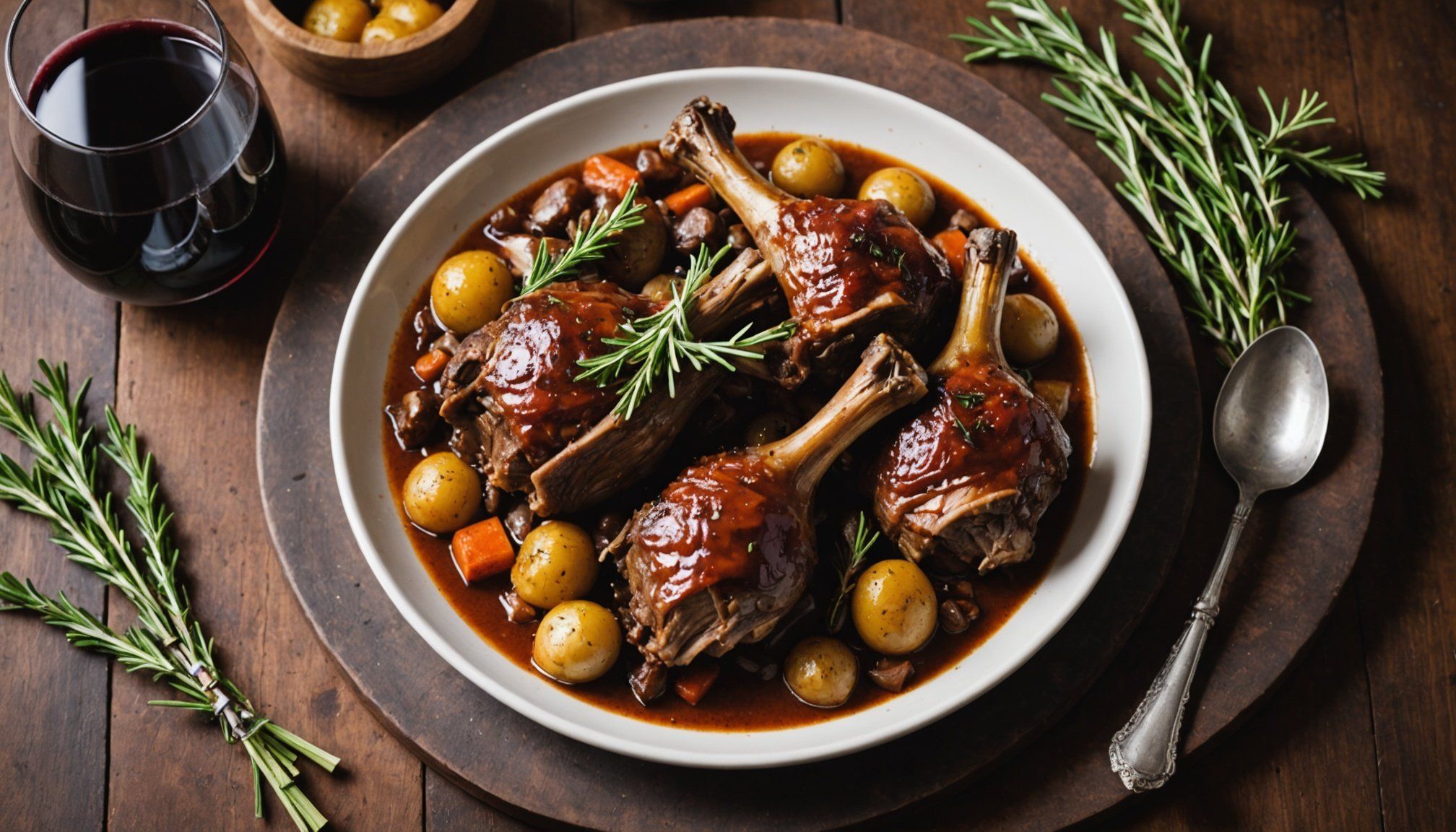Ingredients for Braised Lamb Shank
To create a savoury and aromatic Braised Lamb Shank, start by assembling a selection of key ingredients. The centrepiece is, of course, the lamb shank, celebrated for its rich, meaty flavour and tender texture. Next, secure a bottle of good-quality red wine. This essential ingredient not only imparts depth but also enhances the overall taste profile of the dish. Then, add fresh rosemary, an herb that pairs exceedingly well with lamb, providing a fragrant and earthy note.
Essential Ingredients
- Lamb shank
- Red wine
- Rosemary
Don’t forget the fundamental herbs and spices. They can include garlic, which complements the lamb’s robust flavour, and thyme, which adds a subtle complexity to the dish. Also, onions, carrots, and celery are classic additions that build a deeper, more nuanced flavour base through slow braising.
In parallel : Unlock Culinary Excellence: A Definitive Guide to Cooking Mastery for Guaranteed Success
Ingredient Variations
For those with dietary preferences, ingredients can be adjusted. Consider replacing red wine with a non-alcoholic substitute or vegetable broth. Similarly, herbs like thyme and bay leaves can be replaced or reduced to accommodate personal tastes. These tweaks allow you to customise the dish while retaining its essence and appeal.
Step-by-Step Cooking Instructions
Creating a Braised Lamb Shank Recipe requires a methodical approach to ensure the rich flavours and tender textures are fully developed. Let’s dive into each step of the process:
Additional reading : Unlock the Art of Creating Luxurious Bourbon Vanilla Pudding: Expert Secrets Revealed
Preparing the Lamb
Begin by seasoning the lamb shanks with salt and pepper, allowing the meat to absorb the flavours for a more robust taste. This preparation step is crucial for enhancing the overall depth of your Braised Lamb Shank Recipe.
Searing the Shank
Searing the shank in a hot pan ensures a golden crust that seals in juices, providing a deeper flavour profile. Remember, the key to effective searing lies in a consistent, high heat, and not overcrowding the pan.
Braising Process
Braising is the heart of the dish, requiring patience and precision. Start by placing the seared lamb shanks in a pot with your chosen braising liquid, commonly red wine, then add herbs like rosemary for aromatic depth. Maintain a gentle simmer, covering the pot to lock in moisture. Allow at least 2 to 3 hours for the meat to become tender, turning occasionally. Regularly check the liquid level to ensure it remains halfway up the shanks.
Flavor Pairings and Side Dishes
Pairing your Braised Lamb Shank with the right sides elevates the dining experience. A key aspect is choosing creamy polenta or garlic mashed potatoes, both balancing the rich flavours of the lamb while offering comfort and texture. You can enhance the dish’s visual appeal with seasonal vegetables, such as roasted root veggies or steamed greens. These not only add a pop of colour but bring freshness to the palate, cutting through the robustness of the lamb.
For wine enthusiasts, selecting a deep, earthy red wine mirrors the flavours in the lamb, further marrying the elements of your meal. A full-bodied vintage like Cabernet Sauvignon complements the dish beautifully, deepening the tasting notes experienced with every bite. Alternatively, a smooth Pinot Noir provides a nuanced contrast, accentuating individual ingredients within the shank’s braising juices.
Consider serving with a side of crusty bread for a rustic touch, perfect for sopping up the luscious sauce. Together, these additions create a harmonious meal that emphasizes texture, taste, and a fulfilling culinary journey.
Tips for Achieving Optimal Flavor and Texture
Achieving optimal flavour and texture in your Braised Lamb Shank requires keen attention to detail and technique. One effective method is via marination techniques. Marinating your lamb shank overnight with herbs, spices, and a touch of red wine enhances its natural depth, allowing each bite to burst with harmonised flavours.
It’s vital to consider adjusting cooking times based on the size of the shanks. Larger shanks demand more time in the braising process, while smaller cuts might reach tenderness quicker. The key is a low, slow braise continued until the meat pulls gently from the bone.
For enhancing flavours, layering is crucial. Introduce ingredients like rosemary and garlic in stages, beginning with the marinade and continuing through cooking, to build complex background notes. Towards the end of cooking, test and adjust seasonings and consider reducing the braising liquid to intensify the savoury character of your dish.
Experimenting with these techniques will not only amplify the taste but also make the lamb shank satisfying and tender in texture.
Culinary Significance and Variations
The Braised Lamb Shank stands as a symbol of diverse culinary traditions, woven into the historical context of braising. Braising, a technique of slow cooking in liquid, transforms tougher cuts of lamb into tender, flavourful dishes, capturing aromatics perfectly. Historically, it has roots in many cultures, known for drawing intense flavour from modest ingredients.
This rich recipe enjoys numerous regional variations. In Provence, France, lamb shank may be cooked with olives and herbs like thyme, reflecting Mediterranean flavours. Meanwhile, in Moroccan cuisine, lamb shanks are braised with spices such as cumin and coriander, producing a completely different yet equally enticing experience.
Modern interpretations continue to evolve, blending traditional methods with innovative twists. Chefs might incorporate non-traditional ingredients like Asian spices, or use sous vide devices for precise temperature control before finishing with a braise. These adaptations reflect the ever-expanding boundaries of culinary creativity.
For home chefs and enthusiasts, such variations provide a window into the adaptability of braised lamb shank, inviting experimentation while honouring time-tested techniques. Whether sticking to classic methods or embracing modern changes, each version respects the culinary significance fundamental to this beloved dish.
Visual Presentation and Plating
Plating your Braised Lamb Shank with intention elevates both its aesthetic and tasting experience. The art of garnishing should be deliberate, using fresh herbs such as a sprig of rosemary or a drizzle of sauce reduction for a blend of decorative finesse and added flavour.
Artful Garnishing
Incorporate subtle elements; a sprinkle of finely chopped parsley or a light dusting of zest can refresh its appearance and enhance the palate. Consider how each accent complements the dish visually and flavour-wise.
Effective Use of Colours
Contrast is key in showcasing the lamb’s rich depth against bright, vibrant veggies. Roasted carrots, mashed potatoes, or polenta provide not only texture but also a vivid colour palette. These brilliant hues create a stunning visual contrast with the shank.
Enhancing Dish Appeal
Presentation isn’t just about looks—arrange components thoughtfully to highlight the shank’s tender texture and lustrous braising sauce. Position the lamb on a wide plate, offset by side dishes, to naturally draw the eye. Such techniques underscore the plating techniques crucial for an inviting and appetising meal.









